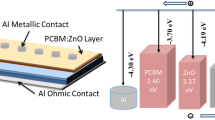Abstract
The main purpose of this study is to investigate the influence of Ga doping ratio on the electrical and optical properties of ZnO. Pure ZnO and Ga-doped ZnO solutions were procured using sol–gel spin coating technique. Next, this solution was deposited onto the p-Si substrate to obtain homogenous thin films. After that, photodiodes were produced using these films. When the process was complete, the morphological structure of the thin films and the electrical and optical properties of the photodiode were studied. Within this scope, while absorbance and transmittance of the thin films were characterized using UV–Vis spectrophotometry, the morphological properties of the thin films were analyzed using atomic force microscope (AFM) and the roughness and fiber size were analyzed using AFM analysis software. On the other hand, the band gap of the thin films was determined using optical absorption values. Additionally, the photocurrent of the ZnO/p-Si photodiode was studied under dark conditions and under various illumination intensities. Likewise, the capacitance and conductance of the photodiode were studied. In addition to these parameters, the Rs–V, C–V, Cadj–V, and Gadj–V characteristics of the photodiode were also studied and the obtained results illustrated graphically. The results showed that the electrical and optical properties of ZnO can be improved and controlled via Ga doping ratio. Therefore, the produced photodiode can be used in optical electronics for different applications as either a photodiode or photosensor.
















Similar content being viewed by others
References
Ahmadi M, Dafeh SR (2016) Electrical and optical study of ultrasonic-assisted hydrothermal synthesized Ga doped ZnO nanorods for polymer solar cell application. Indian J Phys 90:895
Al Orainy RH, Hendi AA (2014) Fabrication and electrical characterization of CdO/p-Si photosensors. Microelectron Eng 127:14
Çavaş M (2002) Investigation morphological, electrical, and optical properties of Mn-doped ZnO thin film by sol–gel spin-coating method. J Theor Appl Phys 11(4):325–331
Cavas M, Alahmed ZA, Albrithen HA, Yakuphanoglu F (2014) Photoresponse and electrical properties of Al/nanostructure NiFe2O4/p-Si/Al photodiode. J Electroceram 32:163–92
Çavaş M, Yakuphanoglu F, Karataş S (2017) The electrical properties of photodiodes based on nanostructure gallium doped cadmium oxide/p-type silicon junctions. Indian J Phys 91:413
Chandiramouli R, Jeyaprakash BG (2013) Review of CdO thin films. Solid State Sci 16:102–772–772. https://doi.org/10.3233/JAD-170650
Chen YM, Ohkubo T, Hono K (2011) Laser assisted field evaporation of oxides in atom probe analysis. Ultramicroscopy 111:562
Kafizas A, Parkin IP (2011) ChemInform Abstract: Inorganic thin-film combinatorial studies for rapidly optimizing functional properties. Chem Soc Rev 41:738
Khusayfan NM (2016) Electrical and photoresponse properties of Al/graphene oxide doped NiO nanocomposite/p-Si/Al photodiodes. J Alloys Compd 666:501
Lv J, Gong W, Huang K, Zhu J, Meng F, Song X, Sun Z (2011) Effect of annealing temperature on photocatalytic activity of ZnO thin films prepared by sol–gel method. Superlattices Microstruct 50:98
Monemdjou A, Ghodsi FE, Mazloom J (2014) The effects of surface morphology on optical and electrical properties of nanostructured AZO thin films: fractal and phase imaging analysis. Superlattices Microstruct 74:19
Murugadoss G, Jayavel R, Kumari MR (2016) Structural, optical and thermal properties of CdS/Bi2S3 nanocomposites. Indian J Phys 90:173
Ocak YS (2012) Electrical characterization of DC sputtered ZnO/p-Si heterojunction. J Alloys Compd 513:130
Salim ET (2013) Optoelectronic properties of Fe2O3/Si heterojunction prepared by rapid thermal oxidation method. Indian J Phys 4:349
Salunkhe RR, Dhawale DS, Patil UM, Lokhande CD (2009) Improved response of CdO nanorods towards liquefied petroleum gas (LPG): effect of Pd sensitization. Sens Actuators B Chem 136:39
Tataroğlu A (2006) Electrical and dielectric properties of MIS Schottky diodes at low temperatures. Microelectron Eng 83:2551
Yang ZX, Zhong W, Yin YX et al (2010) Controllable synthesis of single-crystalline CdO and Cd(OH)2 nanowires by a simple hydrothermal approach. Nanoscale Res Lett 5:961
Zhang D, Uchida K, Nozaki S (2015) Visible-blind ultraviolet photodiode fabricated by UV oxidation of metallic zinc on p-Si. J Appl Phys 118:9
Acknowledgements
The author gratefully acknowledges that this study was conducted using the support of the TUBITAK 2219 program.
Author information
Authors and Affiliations
Corresponding author
Rights and permissions
About this article
Cite this article
Çavaş, M. Improving Electrical and Optical Properties of ZnO/p-Si Optical Sensor. Iran J Sci Technol Trans Sci 44, 289–297 (2020). https://doi.org/10.1007/s40995-019-00803-4
Received:
Accepted:
Published:
Issue Date:
DOI: https://doi.org/10.1007/s40995-019-00803-4




